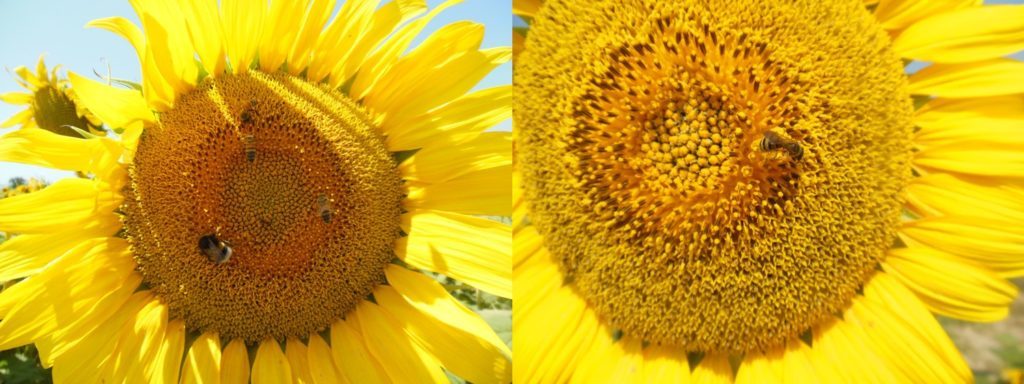Bees rely on flowers to get the nutrients they need – both adults and larvae. Looking at bee nutrition more in detail however, makes clear that it isn’t as simple as that. All 20,000 bee species have different life-histories, have different amounts of offspring, may be social, solitary or something in between. Some species are oligolectic, others forage on a huge variety of plants. All this justifies diverse nutritional demands. This means that there are potentially 20,000 or even more combinations of an ideal bee diet. If we consider that adults and larvae may have distinct needs, this gets even more complex. We know concerningly little about this. However, this knowledge is extremely important for the conservation of bees: their decline is partly linked to the loss of floral resources.
Main nutrients in a bee diet
Like us, bees need carbohydrates, proteins and lipids (fats) – the so-called macronutrients. They get everything they need from only two resources: pollen and nectar. To me, only this is already amazing. It seems like a pretty reduced diet, but it is obviously rich enough to maintain the diversity of bee species. Both larvae and adults need these macronutrients, but the proportions of each may be different. The highly mobile adults need more energy than the larvae. However, both would starve quickly if they don’t get enough carbohydrates. Proteins are important for the growing larvae, but also the adults need them for reproduction. Lipids finally are important as a secondary energy source and have a role in a number of metabolic processes.
So far it may seem quite simple, but of course things are more complex. Both pollen and nectar are very diverse in their composition depending on the plant species. In a nutshell, nectar is the main source for carbohydrates and pollen for protein, lipids and other nutrients like vitamins and minerals. The main sugars in nectar are fructose, glucose and sucrose, but there are also others that contribute to the specific sweetness of the nectar of every flower species. The protein content in pollen may vary between 2-60%, the lipid content between 1-20%. That means that oligolectic species that forage on single plant species must also have very specific physiological adaptations to the distinct nutrients offered by their host plant. Pretty amazing, isn’t it?
Different nutritional demands of bee species
As mentioned above, the differences in life-history of all bee species justify diverse needs for nutrients. In an interesting review of the current knowledge, Vaudo and colleagues state that honey bees and bumblebees regulate their intake of carbohydrates and proteins in favour of the former. That means that they collect more nectar than pollen. This reminded me a study I did in sunflower fields two years ago: I didn’t see a single honey bee with sunflower pollen. Some (few) bumblebees collected pollen, but clearly were more interested in the nectar. On the other hand, the solitary bees were working mainly on the pollen.

Honey bees and bumblebees were mainly foraging on nectar in sunflower fields (left). The solitary species (on the right) were more interested in the pollen.
These observations weren’t the aim of the study, so unfortunately I don’t have real data on this. However, it fits into the arguments of the review.
Every bee species has different demands in the sugar concentration and composition in the nectar. Interestingly, the length of the tongue is correlated to the sugar concentration in the nectar: while honey bees (with quite long tongues) prefer concentrations of 30-50%, short tongued species prefer higher concentrations of 45-60%. Which makes me wonder about bumblebees: species of this group may have quite short up to very long tongues… Even more questions are open concerning the protein needs of different bee species. First, there is the amount of pollen provisioned to the larvae, but also the quality of the protein that pollen from different flowers provides. It seems that honey bees forage more for quantity, while bumblebees prefer pollen with higher protein content. And who knows about solitary bees…
Finally, lipids may play an important role also for the recognition of the quality of pollen. The exterior layer (pollenkitt) is rich in lipids and may stimulate bees to feed on it. And of course, both pollen and nectar also contain other substances like vitamins, minerals and secondary metabolites of the plant that also play a role for bee nutrition. There is still much to learn about all this, also for the less abundant species.
Consequences for conservation
As mentioned above, we know only little about the nutrients all the different bee species need. Honey bees are most studied, but there are lots of open questions also in their case. We already know much less about bumblebee nutrition and it gets really scarce if we talk of all the other bee species. However, more research is extremely necessary if we want to restore the floral resources that got lost in the past decades. It is not enough to mix some flower seeds. Very often, these mixes meet more human aesthetics than diet requirements for bees. And if they are designed for the latter, they mostly consider the preferences of the most known species: honey bees and bumblebees.
However, as we still need all bee species, we also have to consider the whole picture without simplifying. I don’t want to be in the chorus of those who only criticize without ever being content. Every step already taken to improve the floral supply for bees is great. But it’s still much to early to tap ourselves on the shoulder for saving the bees. We still need much research: about the basics of bee nutrition and about the application for conservation. We need monitoring of the existing measures so that we can improve and adapt them to different circumstances. It won’t be easy, but as a dear colleague said some time ago on a conference: that it isn’t easy is no argument not to try.



